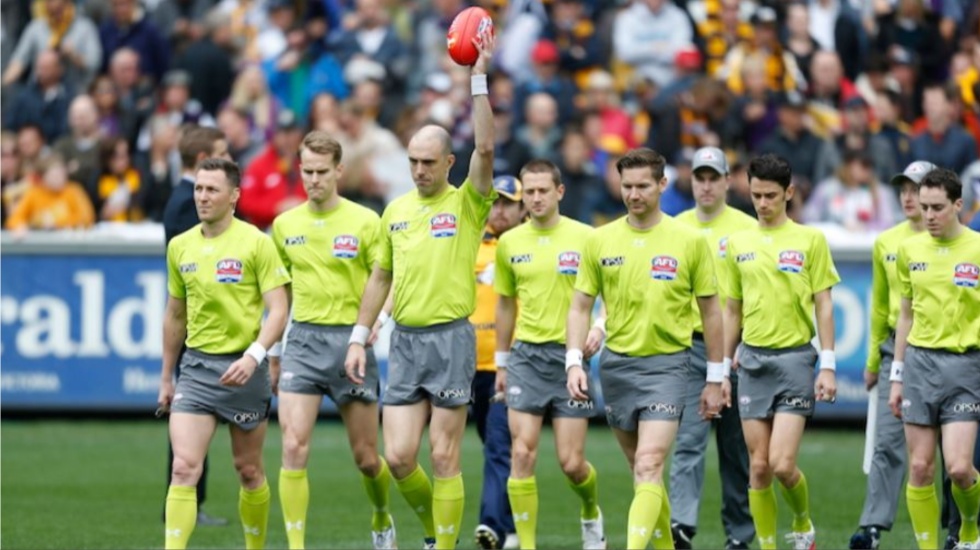I genuinely believe that in all my time watching AFL football, the standard of umpiring has varied little. Photo: AFL MEDIA
Nearly a week on, I’m finding myself revisiting the dramatic finale to the North Melbourne-Collingwood game a fair bit and still wondering about various “ifs” and “buts”.
Something has struck me in doing so, though, and it’s the hiding to nothing that umpires are always on, being actively involved in a game they must love but are rarely anything other than pilloried or abused for it.
Don’t worry, I’m not absolving myself here, I’ve bitched and moaned about this or that decision out loud, on social media, in print or on air any number of times. I probably did it again when North Melbourne’s Bailey Scott wasn’t paid THAT 50-metre penalty last Sunday.
But the few times I watched the last couple of minutes of the game again, I was struck by the errors made by several players as well as that umpiring blunder.
There was Darcy Tucker’s missed snap, which failed to score. There was Zac Fisher’s oh-so-close shot at goal seconds before the siren.
And, in terms of culpability, what I thought was the biggest blunder of them all, Cam Zurhaar’s failure to chip a simple pass to Curtis Taylor, alone and unattended inside 50, choosing instead to handball sideways to Scott, and missing his target by five metres. Zurhaar hits up Taylor, and North Melbourne wins. But he didn’t. And they didn’t.
That sample of a couple of minutes of 120-odd I thought highlighted particularly well just how many errors are made by even the best players over the course of even just a few seconds, let alone four quarters. Most pass unremarked upon. But an umpire makes just one and will be skewered for it.
Yes, it’s always been thus. But it’s the extent of the skewering which really has changed significantly. I have little doubt there’s more complaining about umpiring now than ever before. But does that mean it’s worse than ever? I don’t think so.
I genuinely believe that in all my time watching VFL and AFL football, the standard of umpiring has varied little. And that’s a good thing. They get a high percentage of things right.
They get a few wrong, too, but often that’s as much to do with laws of the game, of which there are more than there used to be, and which leave far more open to interpretation than virtually any other sport you care to name. Even more so now.
The application of the “insufficient intent to keep the ball in play” rule, for example, was until a few years ago reserved for pretty obvious examples of deliberately forcing the ball out of bounds. Its tightening up has forced umpires to far more play the role of mind-reader as to the kicker’s intentions.
Now consider the amount of responsibilities and umpire has during the course of a game. Consider, for example, that now an umpire cannot mentally switch off for even one second. Perhaps it was once possible, just briefly, when a mark was awarded and a player moved back to his mark to take a set kick. Now, however, the man on the mark must be policed even more officiously with the “stand” rule.
And if you want an idea of how many more rules and regulations there are now to be enforced, check out the “Rule Changes” chronology section of the AFL Record Season Guide.
PLEASE HELP US CONTINUE TO THRIVE BY BECOMING AN OFFICIAL FOOTYOLOGY PATRON. JUST CLICK THIS LINK.
In 20 years between 1970 and 1990 (when the VFL officially became known as the AFL) there were 19 rule changes. In the 32 years between 1991 and last year, there were no fewer than 74. And no, that’s not a misprint.
What has also changed dramatically, particularly over the last 20 years or so, is the greater intensity of focus on umpiring from both the football commentariat and the football public.
Think about the extent of AFL coverage now compared to 30 years ago, when several games per week weren’t captured by TV cameras, live or even for replay, nor sometimes even broadcast on radio. Think about a time before there were more football panel shows than you could shake a stick at.
Think of that time before the advent of social media, the contents of which now often becomes a source of news for mainstream media in its own right.
And now think of a time when that mainstream media wasn’t as seemingly obsessed with isolating “talking points” from a game for “hot takes”, and more inclined to discuss those happenings within the context of an actual game of football with the consequent ramifications for a season-long competition.
One newspaper earlier this week produced a list of 10 games this season allegedly decided by controversial umpiring calls. It seems a lot. But now consider that we’ve had 120 games so far this season, of which 31, more than a quarter, have been decided by single-figure margins. Given you can pluck a “controversial” call from pretty much any game played, is that number so surprising?
The fact is that we’ve turned up the temperature on that “hot seat” umpires perpetually occupy to unrealistic levels. Particularly given how much more is now being asked of them. Against that backdrop, I reckon there’s a fair argument they’re doing incredibly well to get it right as much as they do.
And to those who will inevitably scoff at that line of thinking, I ask one very fundamental question. If umpiring now really is worse than ever, what would you actually propose to improve it?
Simplify the rules? Remove interpretation and umpire to the letter of the law? The tightening up on the “hands in the back” rule was one attempt to do so. It simply created more controversy.
Better positioning? The introduction of a fourth umpire has attempted to cover a wider range of angles. But now there is serious debate about whether there are “too many cooks in the kitchen”.
Full-time? Research into that idea has concluded time and again that the umpires already do an enormous amount of decision-making work and studying of example videos, and that more hours of doing so isn’t likely to make a difference and could potentially even have the reverse effect.
There isn’t an idea about improving standards that hasn’t been either implemented already or shot down with good cause. And the bottom line? Those standards are already pretty good, and unlikely to get any better.
Which leaves us all with two options. We either accept things as they are, or those of us who get tired of constant umpire talk simply tune out and just enjoy the footy for what it is. Look, you do you, but me, I’m going to try to focus on both of the above.
This article first appeared at ESPN.










